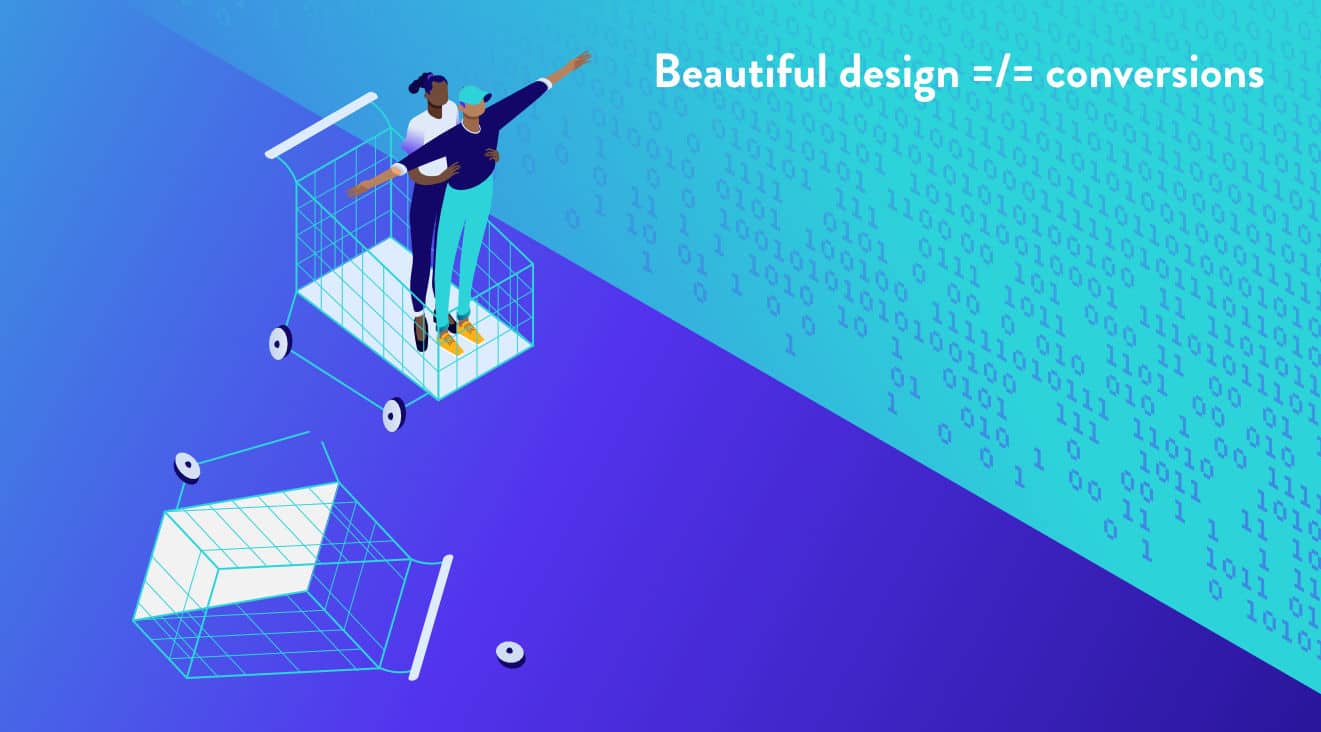The importance of responsive layouts explained by a top web design company
Discovering Imaginative Patterns in Web Design for Modern Companies
The landscape of web design is continuously progressing, showing the vibrant demands of contemporary businesses. Recent trends highlight a choice for minimalism, strong typography, and engaging interactivity. Business progressively prioritize user experience with mobile-first principles and customized content. Furthermore, a concentrate on sustainability is gaining grip. Comprehending these patterns is necessary for companies aiming to stick out in a crowded market. What implications do these shifts hold for the future of digital engagement?
Accepting Vibrant Typography
Vibrant typography has actually become a specifying element in contemporary web design, capturing focus and sharing messages with striking clearness. This trend focuses on aesthetically impactful text that enhances user involvement and brand identity. Designers often use unique typefaces and extra-large fonts to produce a power structure, guiding audiences through content perfectly.
The tactical use vibrant typography enables for efficient storytelling, making it possible for brands to connect their worths succinctly. It offers not only aesthetic purposes however additionally functional ones, as it boosts readability throughout devices and screen sizes.
As web sites contend for user interest, vibrant typography stands apart in a saturated electronic landscape. Its versatility enables designers to trying out contrasting shades and layouts, additionally amplifying its effectiveness. Eventually, accepting bold typography stands for a shift towards more meaningful and communicative web design, promoting a much deeper connection in between brand names and their target markets.
The Rise of Minimalist Layout
As electronic atmospheres end up being progressively cluttered, the surge of minimalist style provides a revitalizing choice that focuses on simplicity and capability. This design viewpoint strips away unneeded components, enabling content to take spotlight. By concentrating on tidy lines, ample white area, and a minimal shade palette, minimalist style improves user experience and boosts navigation.
Companies embracing this trend purpose to share their brand message plainly and efficiently, promoting a sense of tranquility and clarity. The absence of interruptions aids users concentrate on important info, causing improved interaction and conversion prices. In addition, minimalist layout straightens well with mobile-first techniques, making sure that websites stay easy to use and available throughout different gadgets.
Ultimately, the increase of minimalist design shows a wider shift towards focusing on user needs and preferences, making it a powerful device for modern organizations looking to make a lasting effect in the digital landscape.
Immersive Animations and Interactivity
While numerous internet designers welcome minimalist appearances, one more compelling trend getting traction is using immersive computer animations and interactivity. This approach improves user engagement by producing appealing experiences that attract visitors right into the content. Developers utilize dynamic aspects such as animated backgrounds, scrolling effects, and interactive infographics to communicate intricate concepts in an accessible manner.
These computer animations not only supply aesthetic passion yet likewise overview users with the navigation procedure, making interactions extra user-friendly. Float results and animated changes can urge customers to discover additionally, leading to boosted time invested on the website.
This pattern lines up with the wider motion towards narration in internet style, where animations offer as narrative devices that share brand name messages effectively. By integrating immersive animations and interactivity, organizations can differentiate themselves in a congested online landscape, ultimately enhancing user satisfaction and brand name commitment.
Mobile-First Layout Concepts
Mobile-first layout principles highlight prioritizing user experience by making sure internet sites operate seamlessly on smaller sized displays. This method includes receptive format techniques that adjust to various device dimensions while maintaining aesthetic integrity. Additionally, it concentrates on touchscreen navigating layout, boosting usability for mobile customers.
Focusing On User Experience
Just how can designers successfully prioritize user experience in a progressively mobile-centric globe? Highlighting mobile-first design concepts is crucial, as individuals primarily involve with internet sites with smart phones. This strategy urges designers to enhance content, guaranteeing it is conveniently accessible and accessible on smaller sized displays. Trick practices include simplifying navigation, decreasing tons times, and using touch-friendly aspects that boost interactivity. Furthermore, focusing on legible typography and user-friendly layouts can substantially improve user fulfillment. Designers must continually collect user feedback to fine-tune their techniques, adjusting to advancing user demands and choices. By concentrating on these aspects, businesses can develop an appealing digital experience that cultivates loyalty and drives conversions, inevitably straightening with the expectations of today's mobile customers.
Receptive Format Strategies
Designers accept responsive format methods to develop flexible and versatile web experiences that deal with different display sizes. This method focuses on mobile-first design principles, ensuring peak performance on smaller sized devices before scaling up for bigger displays. By making use of liquid grids, versatile images, and media queries, designers can preserve a natural aesthetic identification across all platforms. This strategy not just boosts user involvement however additionally improves online search engine positions, as mobile-friendly sites are favored by search algorithms. Furthermore, receptive formats allow companies to reach a wider target market, fitting individuals on desktop computers, mobile phones, and tablet computers alike. Generally, executing these strategies is important for modern-day web design, ensuring that businesses stay affordable in an ever-evolving digital landscape.
Touchscreen Navigation Design
With the rise of smart phones, touchscreen navigation has come to be an essential element of web design. Designers are progressively adopting mobile-first concepts to boost user experience and engagement. Web Design Agency. Reliable touchscreen navigating focuses on larger buttons and user-friendly motions, permitting individuals to communicate quickly with web content. This method reduces aggravation and motivates expedition, as users can browse seamlessly with their fingers. Furthermore, integrating swipe motions and faucet functionality satisfies the natural actions of mobile users. Responses devices, such as visual signs and computer animations, enhance use additionally by validating actions. As touchscreens control user communications, using these layout components not just aligns with contemporary assumptions however likewise promotes a much more satisfying and accessible browsing experience for all customers
Customized User Experiences
What makes a customer feel truly engaged on a web site? The answer commonly depends on individualized user experiences. By customizing web content and navigation to individual choices, organizations can develop a significant connection with their target market. This customization can be achieved via numerous approaches, such as examining user habits, using cookies, and using tailored recommendations based upon previous communications.
For example, shopping platforms that recommend items based upon surfing history not just enhance user experience however also raise conversion rates. Including dynamic web content that adapts to the user's place or time of day can even more improve engagement.
In addition, individualized greetings or messages can make users feel valued and comprehended. As modern services venture to stick out in an moved here affordable electronic landscape, welcoming customized user experiences ends up being essential, cultivating loyalty and motivating repeat gos to. Ultimately, this method transforms a common internet site right into an interactive platform that reverberates with its target market.
Sustainability in Web Design
As the digital landscape remains to evolve, the significance of sustainability in web design has actually acquired considerable interest. Developers are progressively knowledgeable about the environmental influence their developments can have, prompting a change towards eco-friendly practices (Web Design services). Sustainable web design concentrates on enhancing sites to lower power intake and carbon impacts. Approaches consist of utilizing minimalistic design principles, enhancing pictures, and utilizing reliable coding methods to enhance loading speeds
Moreover, the option of hosting providers plays a vital function; numerous designers are now selecting green organizing solutions powered by renewable resource. By focusing on ease of access and easy to use navigation, sustainable styles also cater to a wider target market, boosting use. This aware strategy not only appeals to environmentally-minded consumers however also adds to the overall longevity and effectiveness of internet sites. Inevitably, sustainability in web design mirrors a growing fad in the direction of responsible digital techniques that straighten with contemporary business values.

Frequently Asked Inquiries
Just How Can I Select the Right Color Pattern for My Internet site?
To select the appropriate color pattern for a website, one ought to think about the brand's identity, target audience, and psychological effect. Making use of color concept and testing combinations can boost user experience and aesthetic appeal substantially.
What Are the Finest Devices for Prototyping Web Designs?
The very best devices for prototyping website design include Figma, Map out, Adobe XD, and InVision. These systems supply intuitive user interfaces, collaboration attributes, and considerable collections, making them suitable for developers to produce and fine-tune their ideas efficiently.
How Do I Gauge the Efficiency of My Web Design?
To determine web design performance, one need to evaluate user involvement metrics, conversion rates, and use feedback (agency for web design). A/B testing and heatmaps can additionally offer understandings into user behavior, leading required adjustments for better performance and user experience
What Prevail Web Design Errors to Stay Clear Of?
Typical web design blunders include messy designs, poor navigating, slow loading times, absence of mobile optimization, insufficient comparison, and disregarding user comments. Preventing these mistakes enhances user experience and raises total performance of the web site.
Just how Commonly Should I Update My Internet Site Layout?
A site design should be upgraded every 2 to 3 years, or earlier if considerable changes in more helpful hints branding or modern technology occur. Regular updates keep the site fresh, practical, and aligned with present user expectations.
